|
AMD/ATI Radeon 5870 Graphics Card

Without getting bogged down with techno-jargon, there is
a new superpower on the block in the single GPU market and this my friends is the ATI Radeon
HD 5870 that for now is the world’s most powerful consumer graphic
card of this weight division.
Of course, besides offering a wide gamut of new technological features to improve
performance and power, this card is also the world’s first to support
Microsoft’s powerful DirectX 11, paving the way for the future of
gaming. AMD have also informed us that on
certain games, this card is twice as powerful as the Radeon HD 4800
series and as Jack Palance would say Believe it or not!
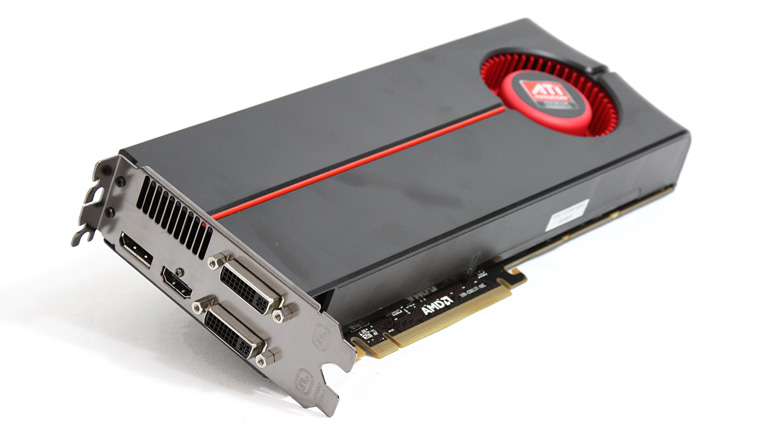
Of course this is the first bullet in the latest war
between AMD and Nvidia but for now, AMD are once again the alpha pack in
the graphic card industry. To add fuel to the fire, the pricing of the
card is quite affordable at around $550AUD, ensuring a stronger
dominance on the market but without further adieu, let’s see those
technological features.
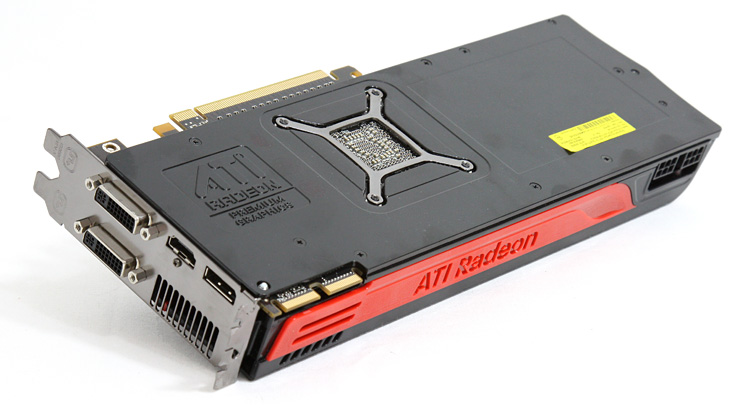
Specifications
| |
Radeon HD 4870 |
Radeon HD 5870 |
| Process |
55nm |
40nm |
| Transistors |
956M |
2.15B |
| Die Size |
263
mm˛ |
334
mm˛ |
| Core Clock |
750
MHz |
850
MHz |
| Shader
Processors |
800 |
1600 |
| Compute
Performance |
1.2
TFLOPs |
2.72
TFLOPs |
| Texture Units |
40 |
80 |
| Texture Fillrate |
30.0
GTexels/s |
68.0
GTexels/s |
| ROPs |
16 |
32 |
| Pixel Fillrate |
12.0
GPixels/s |
27.2
GPixels/s |
| Z/Stencil |
48.0
GSamples/s |
108.8 GSamples/s |
| Memory Type |
GDDR5 |
GDDR5 |
| Memory Clock |
900
MHz |
1200
MHz |
| Memory Data Rate |
3.6
Gbps |
4.8
Gbps |
| Memory Bandwidth |
115.2 GB/s |
153.6GB/s |
| Maximum Board
Power (TDP) |
160W |
188W |
| Idle Board Power |
90W |
27W |
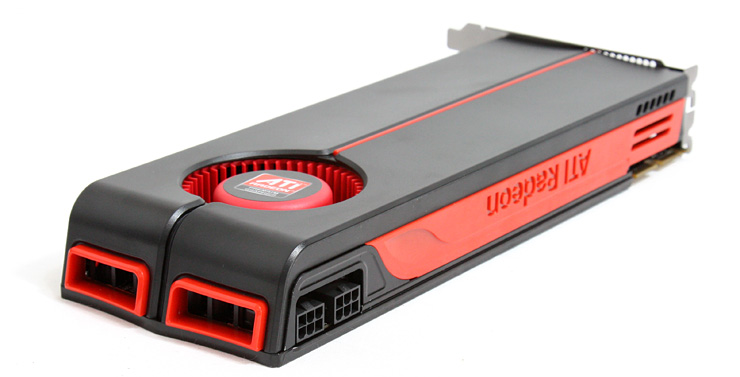
The most noticeable feature of the specifications is the
outrageously high transistor count of 2150 million which also uses 40nm
technology. The old analogy of smaller is better works in this instance.
Compared to the previous powerhouse from AMD, the Radeon HD
4870 had 7.50 GLOPS/W with the Radeon HD 5870 almost doubling that at
14.48 GLOPS/W. So what on Earth is a GFLOP? In laymen's terms, it
basically a way of measuring the performance of computers and needless
to say, the 5870 is waaaay up there in power. In essence, it has almost
doubled a variety of specifications from the Radeon HD 4870 which is
very impressive feat in itself.
Key Features
-
1GB GDDR5 memory
-
ATI Eyefinity technology
with support for up to three displays (1,3)
-
Window 7 support
-
ATI Sream technology (2)
-
Designed for DirectCompute
5.0 and OpenCL
-
Accelerated Video
Transcoding (AVT) (2,4)
-
Compliant with DirectX® 11
and earlier revisions
-
Supports OpenGL 3.2
-
40 nm Process technology
-
ATI CrossFireX™ multi-GPU
support for highly scalable performance (5)
-
ATI Avivo™ HD video and
display technology (6,7)
-
Dynamic power management
with ATI PowerPlay™ technology (6)
-
Display Port, HDMI, 2xDL-DVI
-
PCI Express® 2.0 support
The card also uses the latest GDDR5 memory that runs at
1200Mhz and the core clock speed of the card runs at a speedy 850Mhz.
You might be thinking that cooling this beast is another feat in itself
and AMD have truly revolutionised the cooling capability of this card.
In reference the graphics chip on this card,
the Cypress XT GPU, the developers use a variety of heat
dispersion technologies that moves the air to the back of the card and
in theory, outside your case. As opposed to the Radeon HD 4870, the 5870
is considerably quieter than its older sibling and runs at an acceptable
27 watts while idle and up to 188 watts while in a high-end gaming mode.
Technology Features
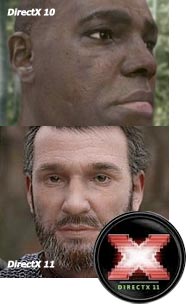
Microsoft DirectX®11
DirectX® 11 is a key feature of Windows® 7 and is important for
two key reasons: it helps consumers experience better performing
games and faster computing. |
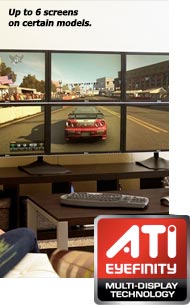
ATI Eyefinity technology with DisplayPort
connectivity, enables a single GPU to support up to six
independent display outputs simultaneously. Boost everyday
productivity, or intensify gaming with ultra-immersive playing
environments. |
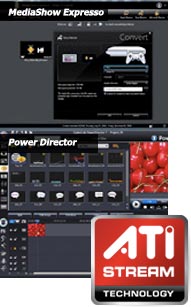
ATI Stream Technology is a set of advanced
hardware and software technologies that enable AMD graphics
processors (GPU), working in concert with the system’s central
processor (CPU), to accelerate many applications beyond just
graphics. |
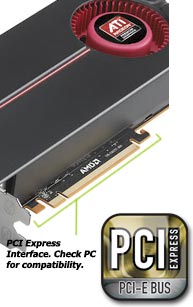 |
PCI Express 2.0
solutions double the bandwidth of the existing PCI Express bus
delivers faster graphics and enhanced system performance.
Additionally, it supports Advanced Power Management features,
leading the industry to optimize overall system energy
efficiency. |
Tessellation
Tessellation is a technique used for many years in the creation of CG
film and television effects to add detail to 3D images and it’s now
available to PC developers for real time rendering via DirectX 11.
Tessellation is truly critical for more realistic environments and
characters:
-
Create dynamic water
surfaces – look more realistic than ever before
-
Create dynamic
clothing on characters – more accurate interaction with environments
including wind and movement
-
Create more detailed
crowds – high levels of detail no longer need to be limited to
characters in the front rows
Multi-Threading
Multi-threading support built into DirectX 11 enables rendering tasks
assigned to the CPU to be efficiently spread across AMD’s multiple
cores, enabling a better balance of performance between the CPU and GPU.
Compute Shaders
Compute Shaders are programs that are executed on the graphics
processor. With DirectX 11 and DirectCompute, developers are able to use
the massive parallel processing power of modern GPUs to accelerate a
much wider range of applications that were previously only executable on
CPUs.
-
Optimized
post-processing effects – apply advanced lighting techniques to
enhance the mood in a scene
-
High quality shadow
filtering – no more hard edges on a shadow, see shadows the way you
would in real life
-
Depth of field – use
the power of the GPU to have more realistic transitions of focal
points - imagine looking through a gun sight or a camera lens
-
High definition
ambient occlusion – incredibly realistic lighting and shadow
combinations
Installation
The first thing we noticed about the card was the weight
which is almost 1 kilo of gaming goodness. The card is quite large and
the dimensions are 27.9 X 11
X 3.8mm, so you need to careful installing the card
in order to prevent any drops on the motherboard. Once slotted into the
motherboard, you need to connect two 6-pin PCI express power connectors into
the card and with that said, you do need a relatively powerful power
supply for this unit. A case with good cooling is also another pro!
Of course you can link more cards together via Crossfire
but interestingly enough, this single card supports up to three monitors
with a resolution of 2560x1600. This is quite amazing and the scope for
gaming and application workspace is unparalleled. Of course, we tested
this feature with three monitors and wow, it’s definitely something out
of the realm of science fiction.
Once the card was installed, we installed the latest BETA
drivers for this card on Windows Vista. Thankfully new drivers have been
made available since our initial testing and in order to fully utilize the features of the Radeon
HD 5870, our main testing was done on Windows 7 Ultimate (64-bit).
DirectCompute
The biggest change to the graphic card market is
DirectCompute which basically allows the card to be used as an
additional processor for your PC which is another reason why this card
works better under Windows 7. It's basically parallel processing and we
believe that this will definitely change the face of computing as we
know. When compared to Windows Vista, the card performance a little
faster, however for pure application and gaming goodness, Windows 7 is
definitely the way.
The minimum
specifications to run this card include
PCI Express or PCI Express 2.0
compliant motherboard with one X16 graphics slot, 500 Watt or greater
power supply with two 75W 6-pin PCI Express® power connectors
recommended (600 Watt and four 6-pin connectors for ATI CrossFireX™
technology in dual mode) and a minimum 1GB of system memory.
Test Machine
As a guide, we tested the HD 5870 on an AMD Phenom X4 9850, 4GB of RAM and a 500GB Seagate Hard Drive.
The software was Windows 7 Ultimate (64-bit) with the latest drivers and
updates plus the new DirectX.
Benchmarking
We tested the card on a fresh system and you must understand that neutral benchmarking is a
difficult zone to achieve as computers can be tweaked so differently.
Using Windows 7 was a breeze with this card and compared to our old
card, everything seemed to look sharper, more colourful and crisp.
DVD's and Blu-rays were brilliant and the detail was phenomenal,
especially at FULL HD resolutions and beyond.
Of course, what review would be complete
without a test with Futuremark's 3Dmark Vantage that is almost
considered the ultimate graphical benchmarking tool and the card scored
an impressive 8612 at 1920x1200 resolution with the HD4870 scoring
around 5412 which is a huge jump. Needless to say, that's right up there
on the high end of the spectrum and of course, this program does not
support ALL the features of this card yet either.
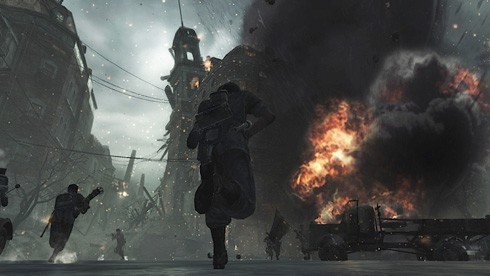
Call of Duty World at War is an extremely
popular military first person shooter and testing the card on a
resolution of 1920x1200, the card scored 92 frames per second on full
detail. With comparison with the HD 4870, it scored around 89 frames per
second. Of course with results like this, the card is definitely
designed for glorious first person shooting usage.
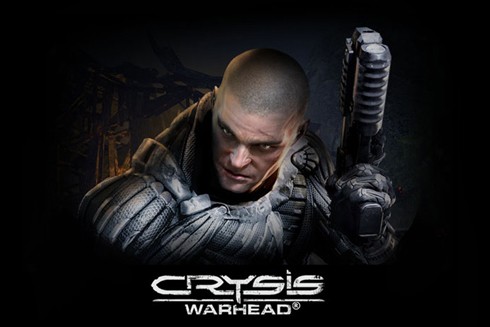
The next game we tested wasrysis Warhead, a first person shooter that has humanity
fighting aliens and needless to say, it's a bugger to run this game at
full detail at full resolution at high detail. Testing the card 1920x1200 again, the HD 5870 scored an
impressive 49 frames per second with the HD 4870 around 41 frames per
second. Quite an impressive result from this new card which relates to
quite acceptable frame rates.
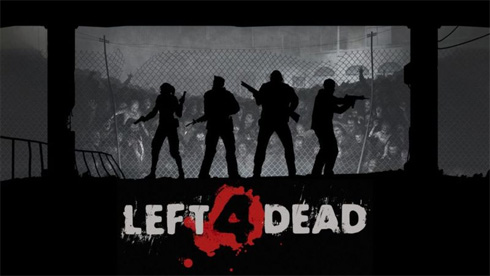
Left for Dead, a fantastic third person
shooter set in a world overrun by zombies is still one of our favourite
games and the HD 5870 scored a thoroughly impressive 119 frames per
second with its older sibling the HD 4870 at 95 frames per second. World
in Conflict is a powerful and quite resource hungry strategy game
and using our standard resolution of 1920x1200, the card scored 55
frames per second with the HD 4870
scoring around 35 frames per second and the performance increase is almost
double.
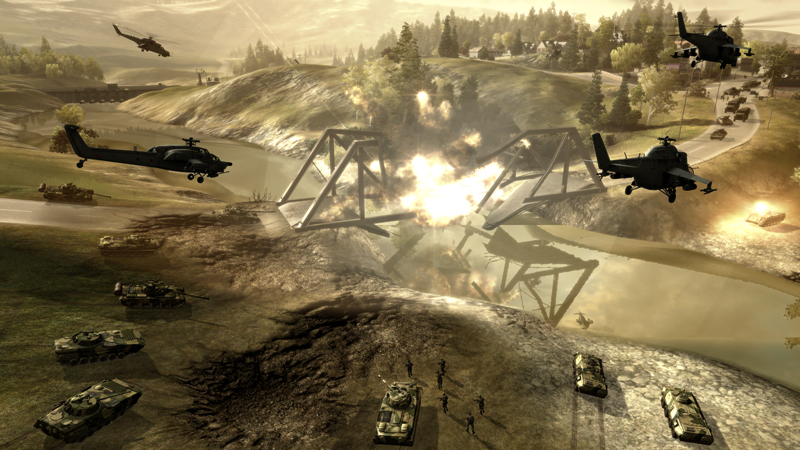
In regards to gaming, the card is the
dominant single GPU card on the market and testing was a little
difficult as the majority of games, well most do not support all the
features of this card, however as developers and the card becomes more
popular, more titles will support it. Compared to the HD 4870, the new
HD 5870 is definitely a contender and on most our tests, this card
easily beat its predecessors and quite a few of the competitive cards on
the market. It's definitely no slouch to gaming and with the ability of
adding, one, two or three monitors, gaming is definitely headed in an
interesting direction.
In terms of power consumption, the card is
definitely quite cool and efficient when in low power mode or at idle,
however for gaming, the card can really heat up, especially if its a
warm day, hence the mention of better cooling for your case. Of course,
power comes at a cost and that my friends is unfortunately the price.
For those who want to push the card even more, you can use the Catalyst
software to push the core clock to 900Mhz and we did see around 5% of
performance increases but I'm sure it has been pushed more.
Conclusion
Although the Radeon HD 5870 is the king of the hill, it
does come at a cost to the gamer, however if you're serious about
gaming, than it's definitely something to consider. AMD have come a long
way since the Radeon HD 4870 and with a few new cards just around the
corner, we're all eager to see where AMD will take us. The biggest
winners for us is the ability of 3 monitors, thanks to EyeFinity,
DirectX 11 and some impressive graphical features such as tessellation.
Of course as more developers begin to support the features of this card,
including Microsoft, we're betting that the future will look quite rosey
for the ATI Radeon HD 5870 by AMD. |